Discover 35 hidden attractions, cool sights, and unusual things to do in Naples (Italy). Don't miss out on these must-see attractions: Museo Archeologico Nazionale, Palazzo Reale, and Museo nazionale di San Martino. Also, be sure to include Castel Nuovo in your itinerary.
Below, you can find the list of the most amazing places you should visit in Naples (Campania).
Table of Contents
Museo Archeologico Nazionale
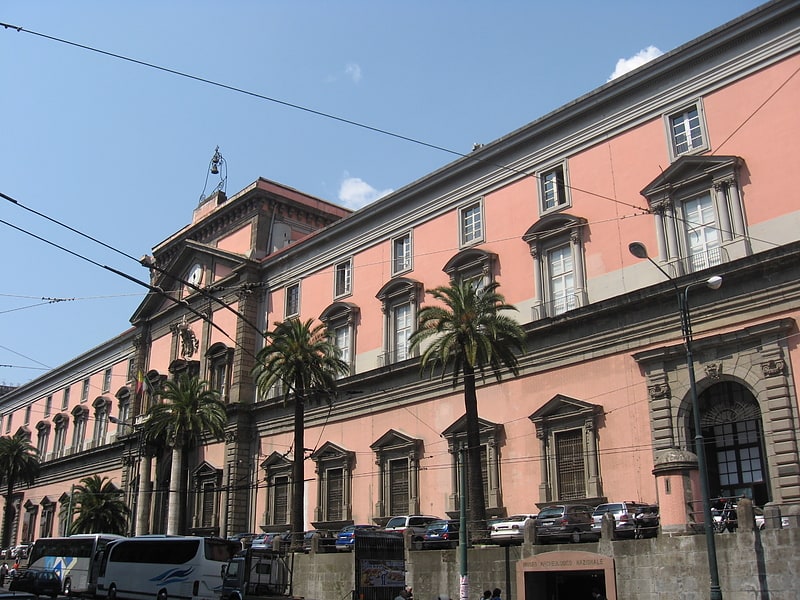
Also known as: Museo archeologico nazionale di Napoli
Museum in Naples, Italy. The National Archaeological Museum of Naples is an important Italian archaeological museum, particularly for ancient Roman remains. Its collection includes works from Greek, Roman and Renaissance times, and especially Roman artifacts from the nearby Pompeii, Stabiae and Herculaneum sites. From 1816 to 1861 it was known as Real Museo Borbonico.[1]
Address: Piazza Museo, 19, 80135 Napoli (Municipalità 4)
Palazzo Reale

Restored palace and royal apartments. The Royal Palace of Naples is a palace, museum, and historical tourist destination located in central Naples, southern Italy.
It was one of the four residences near Naples used by the House of Bourbon during their rule of the Kingdom of Naples (1735–1816) and later the Kingdom of the Two Sicilies (1816-1861). The others were the palaces of Caserta, Capodimonte overlooking Naples and Portici on the slopes of Vesuvius.[2]
Address: Piazza del Plebiscito, 1, 80132 Napoli (Municipalità 1)
Museo nazionale di San Martino
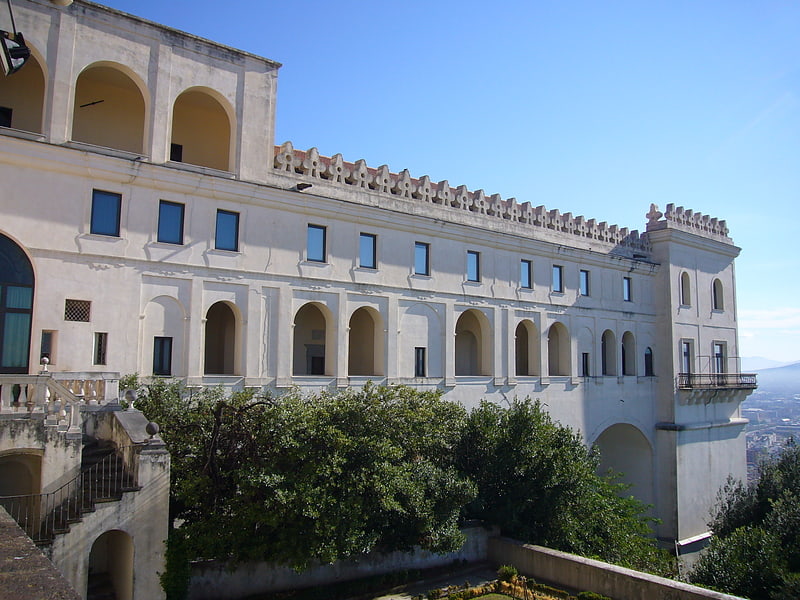
Museum in Italy. The National Museum of San Martino is a museum opened to the public in Naples in 1866, after the unification of Italy, after the Charterhouse included among the suppressed ecclesiastical assets, was declared a national monument.
By the will of the Neapolitan archaeologist Giuseppe Fiorelli, the rooms were intended to collect in a museum evidence of the life of Naples and the southern Kingdoms (Kingdom of Naples and Kingdom of Sicily first and the Kingdom of the Two Sicilies after). The museum, which is spread over two levels, is accessed from the two cloisters of the charterhouse.
Since December 2014, the Ministry of Cultural Heritage and Activities has been managing the museum and charterhouse through the Campania museum complex, which in December 2019 became the Regional Directorate for Museums.[3]
Castel Nuovo
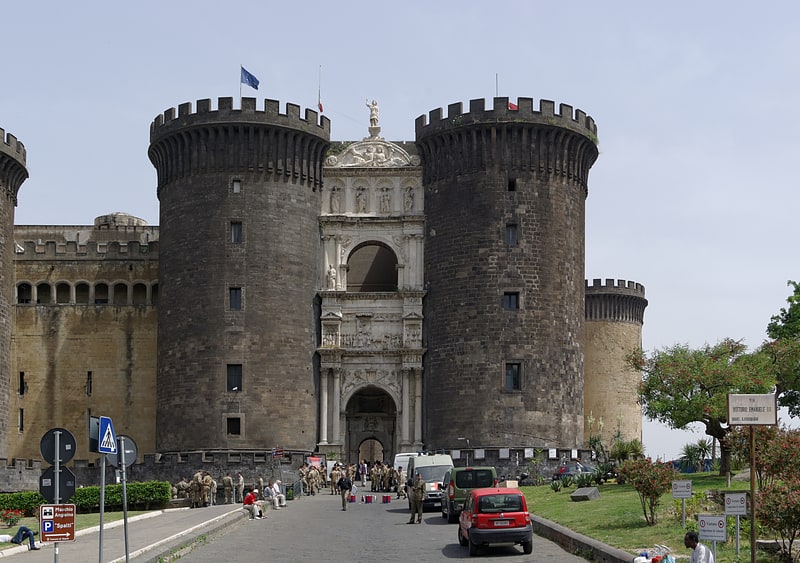
Also known as: Maschio Angioino
Imposing medieval castle and art gallery. Castel Nuovo, often called Maschio Angioino, is a medieval castle located in front of Piazza Municipio and the city hall in central Naples, Campania, Italy. Its scenic location and imposing size makes the castle, first erected in 1279, one of the main architectural landmarks of the city. It was a royal seat for kings of Naples, Aragon and Spain until 1815.
It is the headquarters of Neapolitan Society of Homeland History and of the Naples Committee of the Institute for the History of the Italian Risorgimento. In the complex there is also the civic museum, which includes the Palatine Chapel and the museum paths on the first and second floors.[4]
Address: Via Vittorio Emanuele III, 80133 Napoli (Municipalità 2)
Museo di Capodimonte
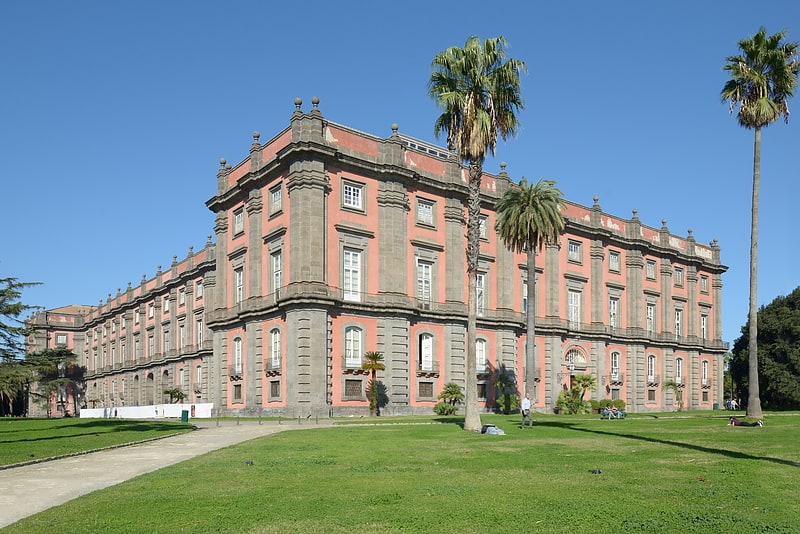
Also known as: Museo nazionale di Capodimonte
Museum of international art and treasures. Museo di Capodimonte is an art museum located in the Palace of Capodimonte, a grand Bourbon palazzo in Naples, Italy. The museum is the prime repository of Neapolitan painting and decorative art, with several important works from other Italian schools of painting, and some important ancient Roman sculptures. It is one of the largest museums in Italy. The museum was inaugurated in 1957.[5]
Address: Via Miano, 2, 80131 Napoli (Municipalità 3)
Phlegraean Fields
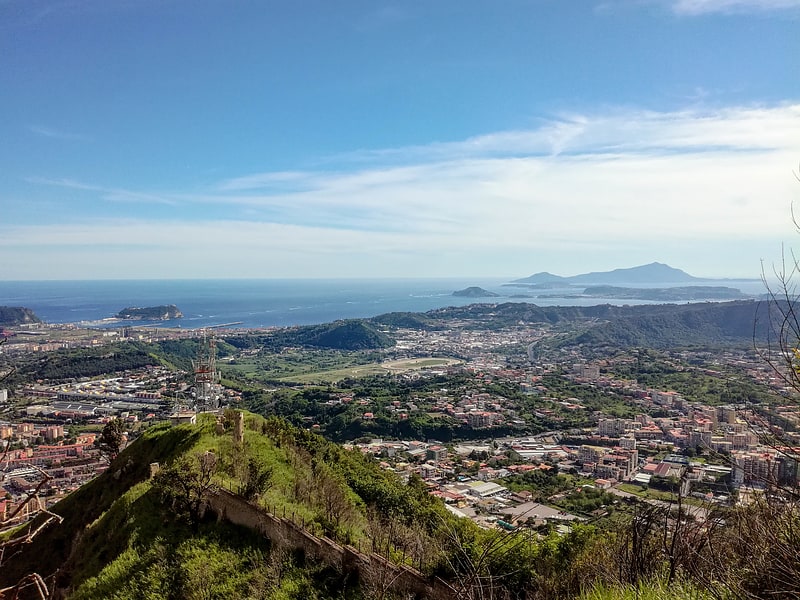
Also known as: Campi Flegrei
Volcanic area of craters and ancient ruins. The Phlegraean Fields is a large volcano situated to the west of Naples, Italy. It was declared a regional park in 2003. The area of the caldera consists of 24 craters and volcanic edifices; most of them lie under water. Hydrothermal activity can be observed at Lucrino, Agnano and the town of Pozzuoli. There are also effusive gaseous manifestations in the Solfatara crater, the mythological home of the Roman god of fire, Vulcan. This area is monitored by the Vesuvius Observatory.
The area also features bradyseismic phenomena, which are most evident at the Macellum of Pozzuoli (misidentified as a temple of Serapis): bands of boreholes left by marine molluscs on marble columns show that the level of the site in relation to sea level has varied.[6]
Madre

Also known as: Museo d'arte contemporanea Donnaregina
Museum in Naples, Italy. The Museo d'Arte Contemporanea Donnaregina, often known as Museo Madre, or Donnaregina Contemporary Art Museum, is a museum of contemporary art in Naples, in Campania in southern Italy. It is housed in the Palazzo Donnaregina, which was adapted for it by the Portuguese architect Álvaro Siza Vieira. The museum opened in 2005.[7]
Address: Via Luigi Settembrini, 79, 80139 Napoli (Municipalità 2)
Castel Sant'Elmo
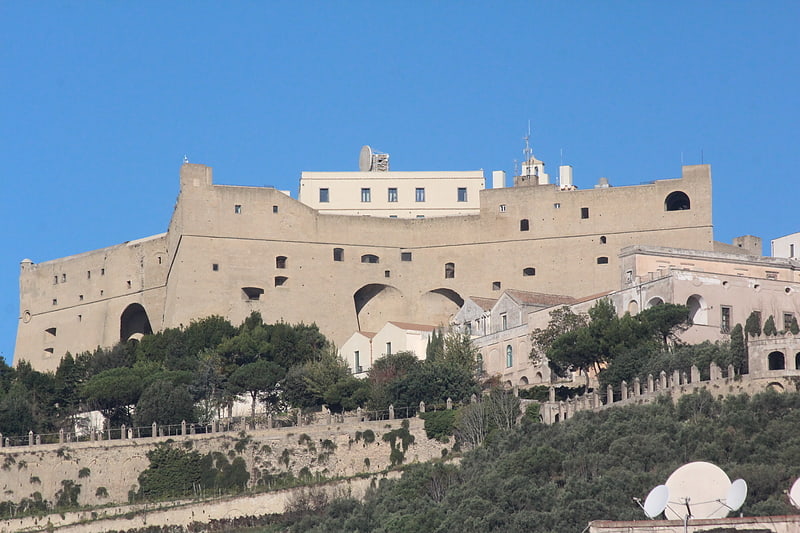
Also known as: Castel sant'Elmo
14th-century fortress and former prison. Castel Sant'Elmo is a medieval fortress located on Vomero Hill adjacent to the Certosa di San Martino, overlooking Naples, Italy. The name "Sant'Elmo" derives from a former 10th-century church dedicated to Sant'Erasmo, shortened to "Ermo" and, finally altered to "Elmo". Located near the upper terminus of the Petraio, one of the city's earliest pedestrian connections between upper and lower Naples, the fortress now serves as a museum, exhibition hall, and offices.[8]
Address: Via Tito Angelini, 22, 80129 Napoli (Municipalità 2)
Certosa di San Martino
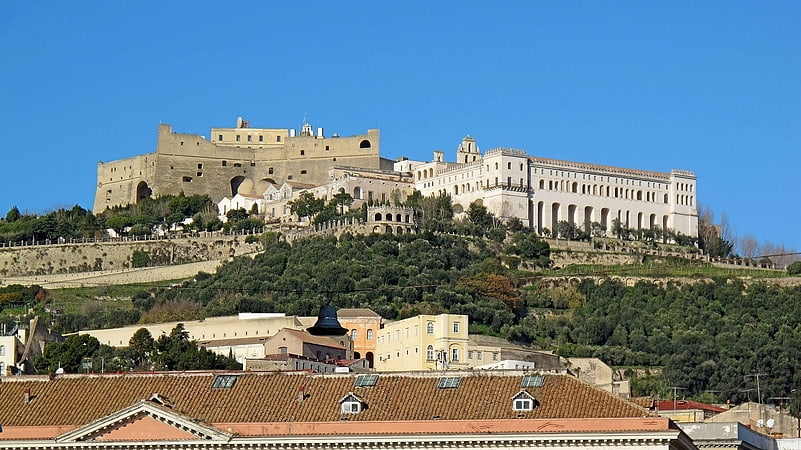
Museum in Italy. The Certosa di San Martino is a former monastery complex, now a museum, in Naples, southern Italy. Along with Castel Sant'Elmo that stands beside it, this is the most visible landmark of the city, perched atop the Vomero hill that commands the gulf. A Carthusian monastery, it was finished and inaugurated under the rule of Queen Joan I in 1368. It was dedicated to St. Martin of Tours. During the first half of the 16th century it was expanded. Later, in 1623, it was further expanded and became, under the direction of architect Cosimo Fanzago, essentially the structure one sees today.
In 1799 anti-clerical French forces of occupation suppressed the monastery and forced the monks to flee. In the ensuing decades the monks made several attempts to reestablish their charter house, with the last effort failing in 1866, when the state definitively confiscated the property. Today, the buildings house the National Museum of San Martino with a display of Spanish and Bourbon era artifacts, as well as displays of the presepe—Nativity scene—considered to be among the finest in the world.[9]
Address: Largo S. Martino, 5, 80129 Napoli (Municipalità 2)
Piazza del Plebiscito
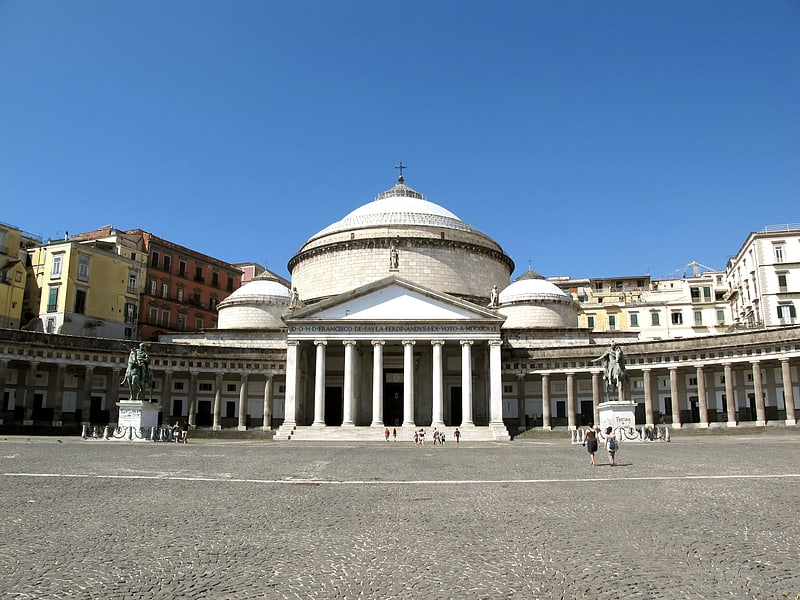
Traffic-free square used for city events. Piazza del Plebiscito is a large public square in central Naples, Italy.[10]
Palazzo di Sangro di Casacalenda
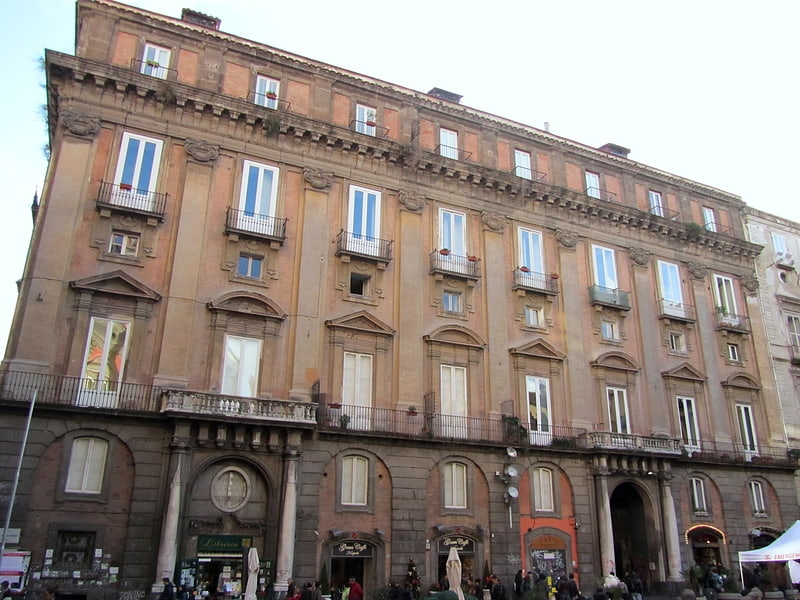
Historical landmark in Naples, Italy. The Palazzo di Sangro di Casacalenda is an 18th-century aristocratic palace located across a pizza from the church of San Domenico Maggiore in central Naples, region of Campania, Italy. The East flank of the facade faces the facade of the church of Sant'Angelo a Nilo.[11]
Address: Piazza San Domenico Maggiore, Naples (Municipalità 2)
Mergellina
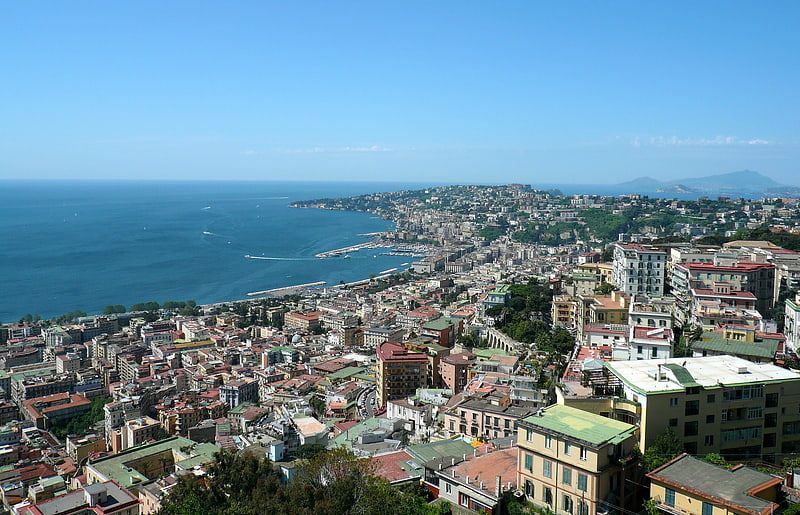
Mergellina is a coastal section of the city of Naples, Italy. It is located in the quartiere of Chiaia. It stands at the foot of the Posillipo Hill and faces the Castel dell'Ovo. Some people tell the name derives from that of a shorebird called "mergoglino". There is some doubt amongst the locals as to the origin of the name "Mergellina". Other people may have the opinion that it is a corruption of "Mare Giallo" which refers to when the sea turned yellow due to floating tufa rock dust following a volcanic eruption many centuries ago. However very likely the real origin of the name is from Latin "mare ialinum", that stands for clear, transparent sea.[12]
San Domenico Maggiore
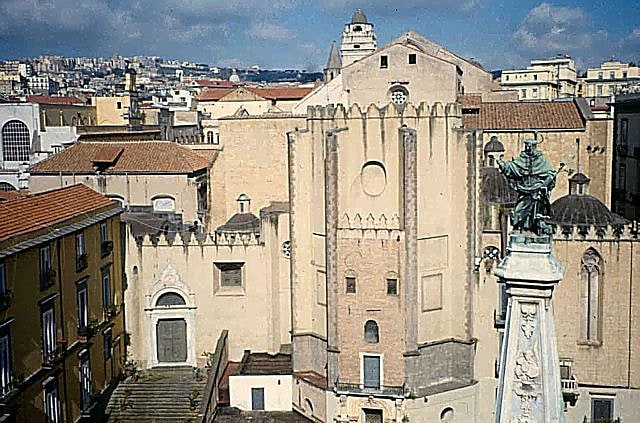
Opulent church with frescos and tombs. San Domenico Maggiore is a Gothic, Roman Catholic church and monastery, founded by the friars of the Dominican Order, and located in the square of the same name in the historic center of Naples.[13]
Address: Piazza S. Domenico Maggiore, 8A, 80134 Napoli (Municipalità 2)
Villa Rocca Matilde
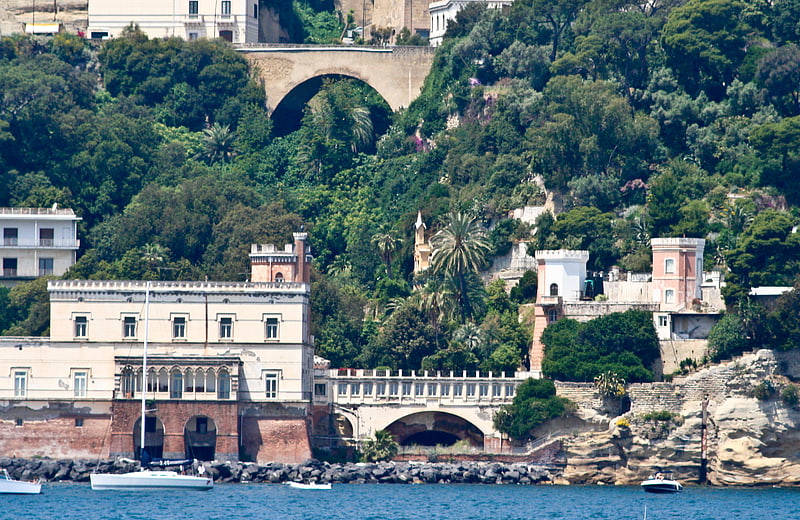
Villa Rocca Matilde is a 19th-century seaside villa, located on Via Posillipo #222, below Piazza San Luigi, in the neighborhood of Posillipo, Naples, Italy.[14]
Museo del Corallo
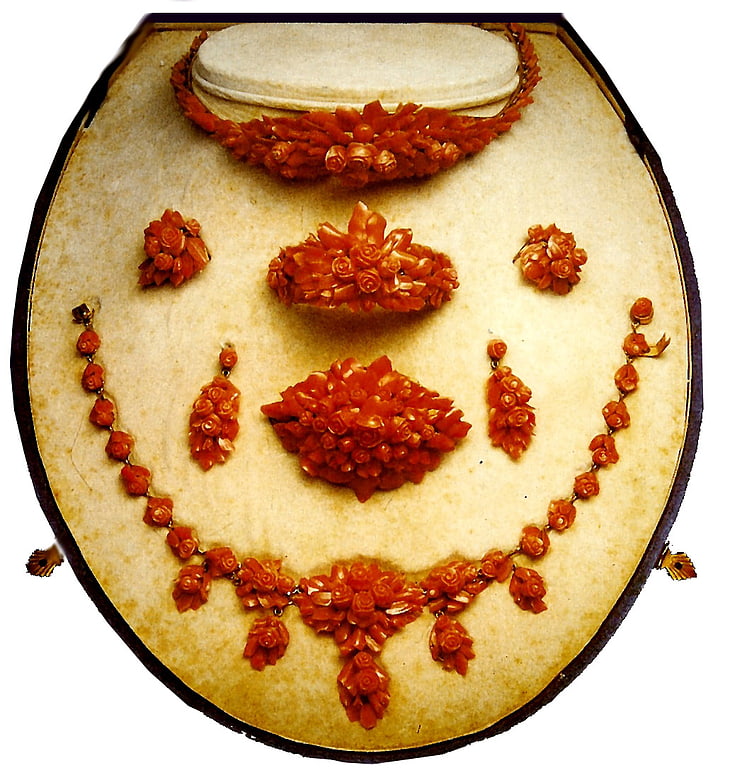
Also known as: Museo del corallo
Museum in Naples, Italy. The Museo del Corallo is a small private museum of coral jewellery in Naples, in Campania in southern Italy. It also holds some cameos and jewellery in ivory and tortoiseshell. The works date from 1805 to 1950.[15]
Address: Piazzetta Matilde Serao, 19, 80132 Napoli (Municipalità 1)
San Francesco di Paola
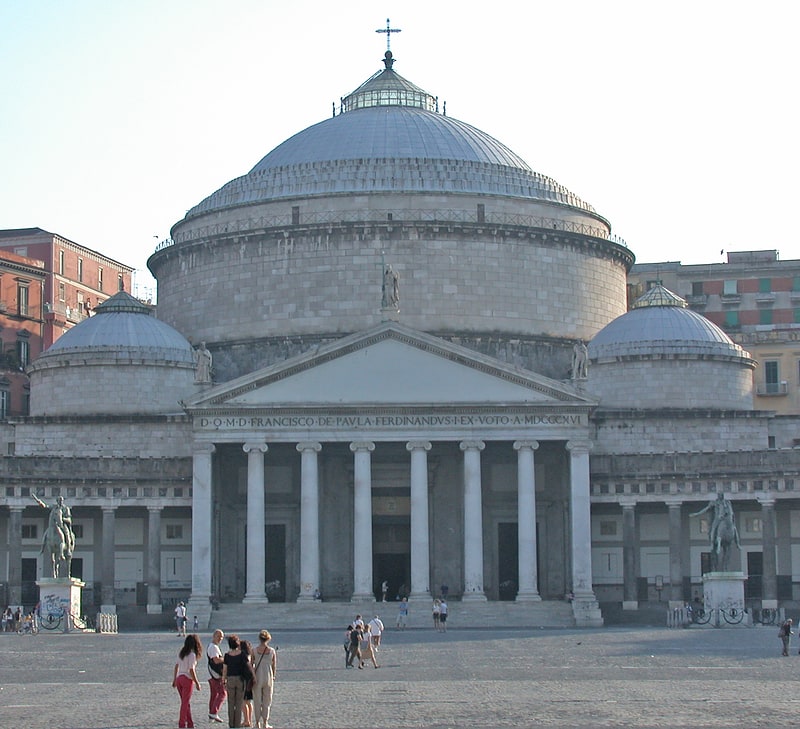
Art-rich circular neo-classical church. San Francesco di Paola is a prominent church located to the west in Piazza del Plebiscito, the main square of Naples, Italy.
In the early 19th century, King Joachim Murat of Naples (Napoleon's brother-in-law) planned the entire square and the large building with the colonnades as a tribute to the emperor. When Napoleon was finally dispatched, the Bourbons were restored to the throne of Naples. Ferdinand I continued the construction - finished in 1816 - but converted the final product into the church one sees today. He dedicated it to Saint Francis of Paola, who had stayed in a monastery on this site in the 16th century.
The church is reminiscent of the Pantheon in Rome. The façade is fronted by a portico resting on six columns and two Ionic pillars. Inside, the church is circular with two side chapels. The dome is 53 metres (174 ft) high. The portico is by Neapolitan architect Leopoldo Laperuta, while the main building is by the Swiss architect Pietro Bianchi.[16]
Address: Piazza Plebiscito, 80132 Napoli (Municipalità 1)
Napoli Sotterranea

Tourist attraction in Naples, Italy. Running beneath the Italian city of Naples and the surrounding area is an underground geothermal zone and several tunnels dug during the ages. This geothermal area is present generally from Mount Vesuvius beneath a wide area including Pompei, Herculaneum, and from the volcanic area of Campi Flegrei beneath Naples and over to Pozzuoli and the coastal Baia area. Mining and various infrastructure projects during several millennia have formed extensive caves and underground structures in the zone.[17]
Address: Piazza San Gaetano, 68, 80138 Napoli (Municipalità 2)
National Museum of Ceramics

Also known as: Museo nazionale della ceramica Duca di Martina
Museum. The National Museum of Ceramics Duca Di Martina is a historical and artistic site situated inside of the Villa Floridiana Park in Naples, Italy. The building used to be one of Campania’s Bourbon royal residences and since 1927 this residence has hosted the museum.[18]
Address: Via Domenico Cimarosa, 77, 80127 Napoli (Municipalità 1)
Teatro di San Carlo

Ornate 18th-century opera house. The Real Teatro di San Carlo, as originally named by the Bourbon monarchy but today known simply as the Teatro San Carlo, is an opera house in Naples, Italy, connected to the Royal Palace and adjacent to the Piazza del Plebiscito. It is the oldest continuously active venue for opera in the world, having opened in 1737, decades before either Milan's La Scala or Venice's La Fenice.
The opera season runs from late January to May, with the ballet season taking place from April to early June. The house once had a seating capacity of 3,285, but has now been reduced to 1,386 seats. Given its size, structure and antiquity, it was the model for theatres that were later built in Europe.[19]
Address: Via San Carlo, 98F, 80132 Napoli (Municipalità 1)
Stadio Diego Armando Maradona
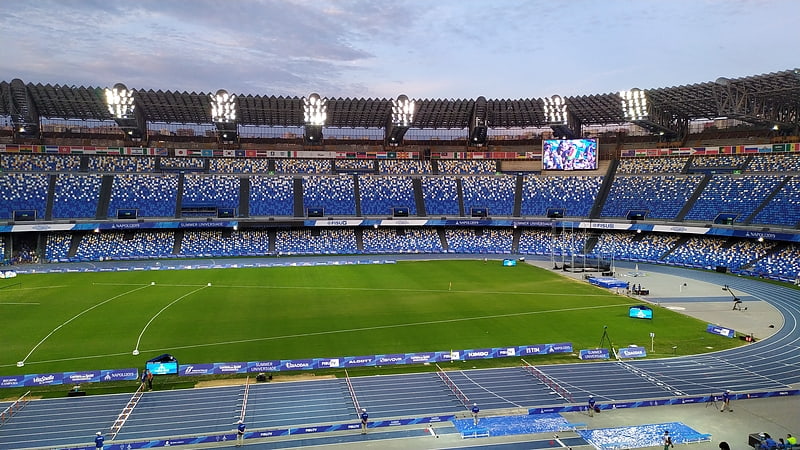
Also known as: Stadio San Paolo
Stadium in Naples, Italy. Stadio Diego Armando Maradona, formerly named Stadio San Paolo, is a stadium in the western Fuorigrotta suburb of Naples, Italy. It is the third largest football stadium in Italy, after Milan's San Siro and Rome's Stadio Olimpico, as well as the largest to be used by only one team. For the 1960 Summer Olympics in Rome, the stadium hosted the football preliminaries. It is currently used mostly for football matches and is the home stadium of S.S.C. Napoli. Constructed in 1959, the stadium was extensively renovated in 1989 for the 1990 World Cup and again in 2018. The stadium currently accommodates 60,240 spectators.[20]
Address: Via Giambattista Marino, 80125 Napoli (Municipalità 10)
Molo San Vincenzo Lighthouse
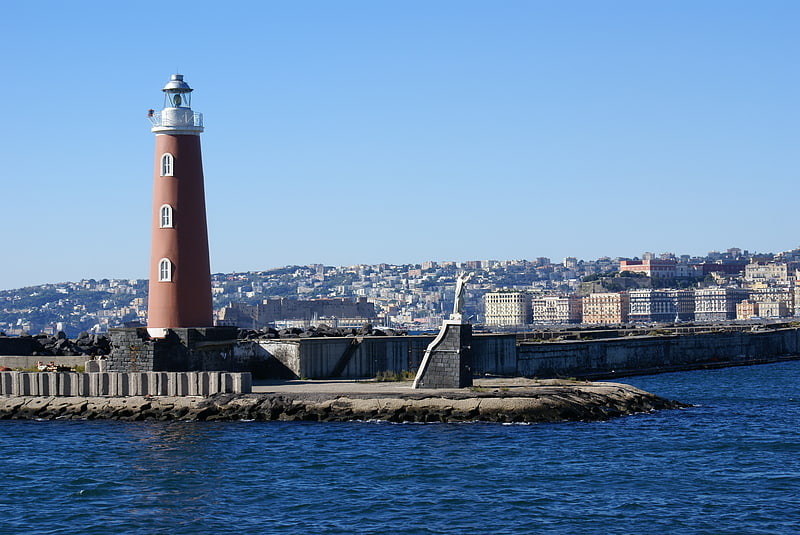
Molo San Vincenzo Lighthouse is an active lighthouse located at the end of the western side to the entrance of the Port of Naples, Campania on the Tyrrhenian Sea.[21]
Palace of the Immacolatella
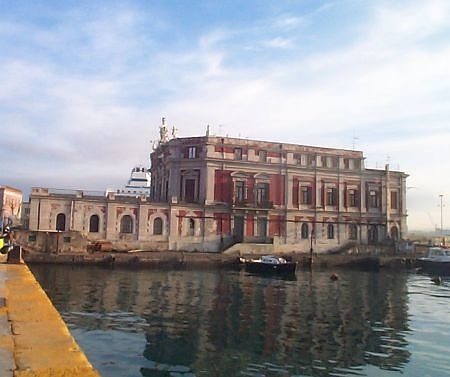
Also known as: Palazzo dell'Immacolatella
Historical landmark in Naples. The Palace of the Immacolatella is a late Baroque style palace at water's edge in Naples, Italy.
The palace design is attributed to the multifaceted painter, sculptor, and architect, Domenico Antonio Vaccaro and it was completed in 1740s to the quarantine station for the port of Naples. At the time, it stood on a peninsula connected to the mainland, connected through the church of Santa Maria del Portosalvo (Holy Mary of the Safe Haven). The area to the north was filled in the 1930s.
The palace is so named because of the statue of the Immaculate Conception by Francesco Pagano, which stands on the roof line over the entrance. The famous Immacolatella fountain, now called Fountain of the Giant, was initially associated with the building, and designed by Michelangelo Naccherino. It was relocated and now stands on the seaside road, via Nazario Sauro, near the Castel dell'Ovo.[22]
Teatro Mercadante
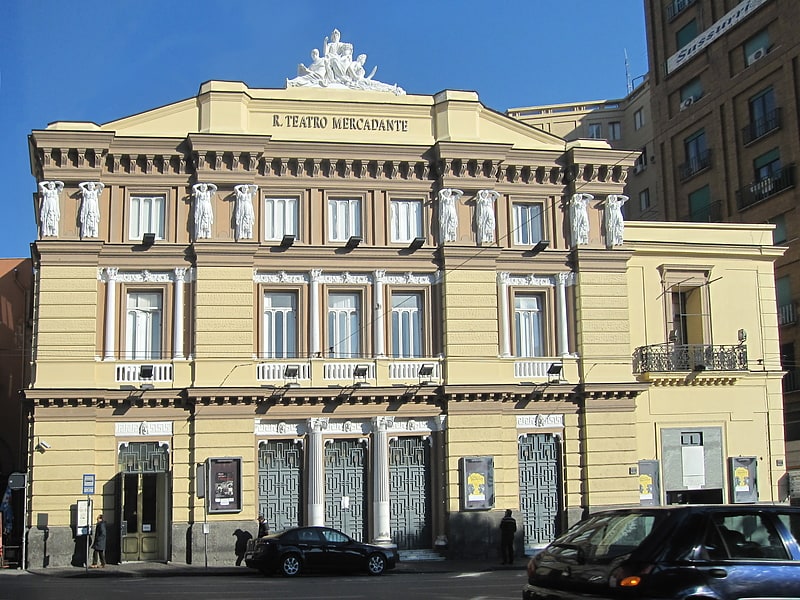
Theatre in Naples, Italy. The Teatro del Fondo is a theatre in Naples, now known as the Teatro Mercadante. It is located on Piazza del Municipio #1, with the front facing the west side of Castel Nuovo and near the Molo Siglio. Together with the Teatro San Carlo, it was originally one of the two royal opera houses of the 18th and 19th-century city.
It opened in 1779 as the 'Teatro del Real Fondo di Separazione', with comic operas sung mainly in Tuscan. The Mozart operas Don Giovanni, The Marriage of Figaro and Così fan tutte were performed there (1812-1815) and also a number of French operas under the patronage and influence of Joseph Bonaparte, King of Naples (1806-1808). The theatre was later used by Gioachino Rossini, who became the music director of the royal theatres, Giovanni Pacini and Gaetano Donizetti and many other leading composers.
After a period of relative inactivity, in 1871 it was renamed the Real Teatro Mercadante, after Saverio Mercadante, whereupon opera productions once again flourished at the theatre.
It is now part of the Teatro Stabile Napoli.[23]
Address: Piazza Municipio, 1, 80133 Napoli (Municipalità 2)
San Lorenzo Maggiore
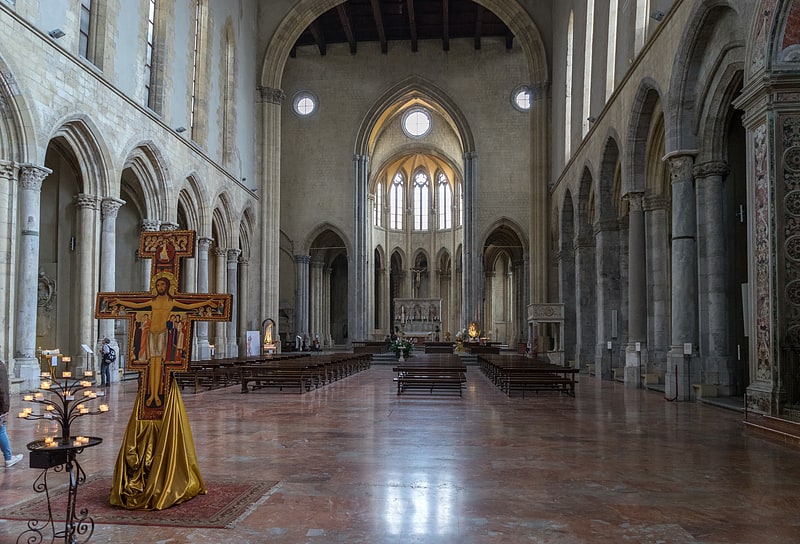
Art-filled 1200s church and Roman remains. San Lorenzo Maggiore is a church in Naples, Italy. It is located at the precise geographic center of the historic center of the ancient Greek-Roman city, at the intersection of via San Gregorio Armeno and via dei Tribunali. The name "San Lorenzo" may also refer to the new museum now opened on the premises, as well as to the ancient Roman market beneath the church itself, the Macellum of Naples.
The church's origins derive from the presence of the Franciscan order in Naples during the lifetime of St Francis of Assisi, himself. The site of the present church was to compensate the order for the loss of their earlier church on the grounds where Charles I of Anjou decided to build his new fortress, the Maschio Angioino in the late 13th century.
San Lorenzo actually is a church plus monastery. The new museum takes up the three floors above the courtyard and is given over to the entire history of the area that centers on San Lorenzo, beginning with classical archaeology and progressing to a chart display of historical shipping routes from Naples throughout Magna Grecia and the Roman Empire. The museum provides a detailed account of the local "city hall" that was demolished in order to put up the church in the 13th century and continues up past the Angevin period and into more recent history.
Beneath San Lorenzo, about half of an original Roman market has been excavated. The site has been open since 1992, the result of 25 years of painstaking excavation. The market place is the only large-scale Greek-Roman site excavated in the downtown area.
In this church Boccaccio met his beloved Fiammetta (1338).[24]
Address: Via dei Tribunali, 316, 80138 Napoli (Municipalità 2)
Stadio Arturo Collana
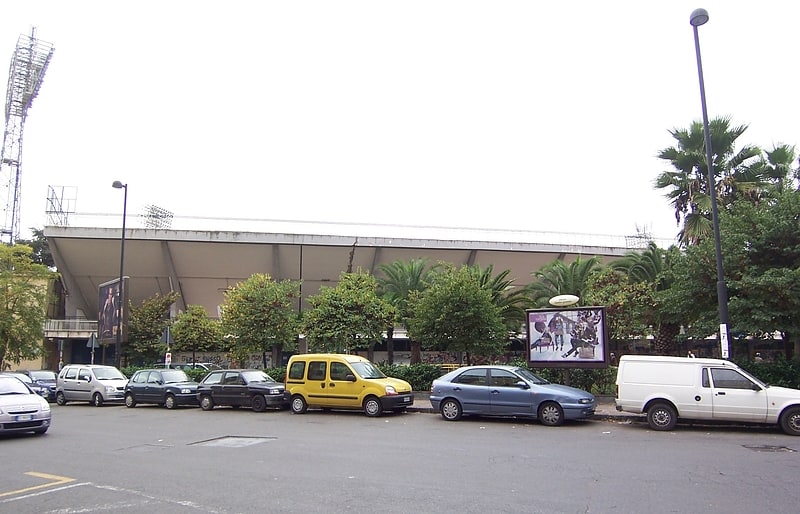
Stadium in Naples, Italy. Stadio Arturo Collana is a football stadium in Naples, Italy; it is located in the Vomero area of the city. The stadium was built in the latter part of the 1920s, originally under the name Stadio XXVIII Ottobre.[25]
Address: Via Giuseppe Ribera, 80128 Napoli (Municipalità 5)
San Paolo Maggiore
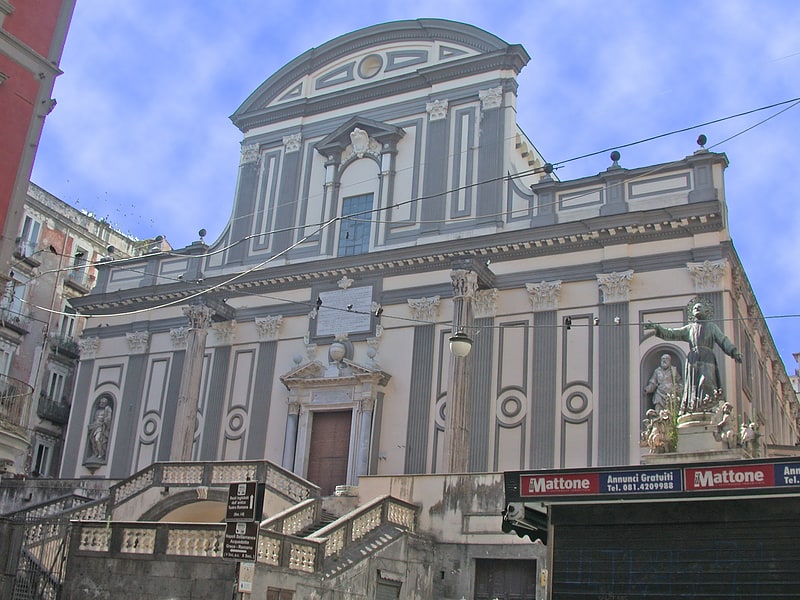
Catholic church with an ornate interior. San Paolo Maggiore is a basilica church in Naples, southern Italy, and the burial place of Gaetano Thiene, known as Saint Cajetan, founder of the Order of Clerics Regular. It is located on Piazza Gaetano, about 1-2 blocks north of Via dei Tribunali.[26]
Gesù Nuovo
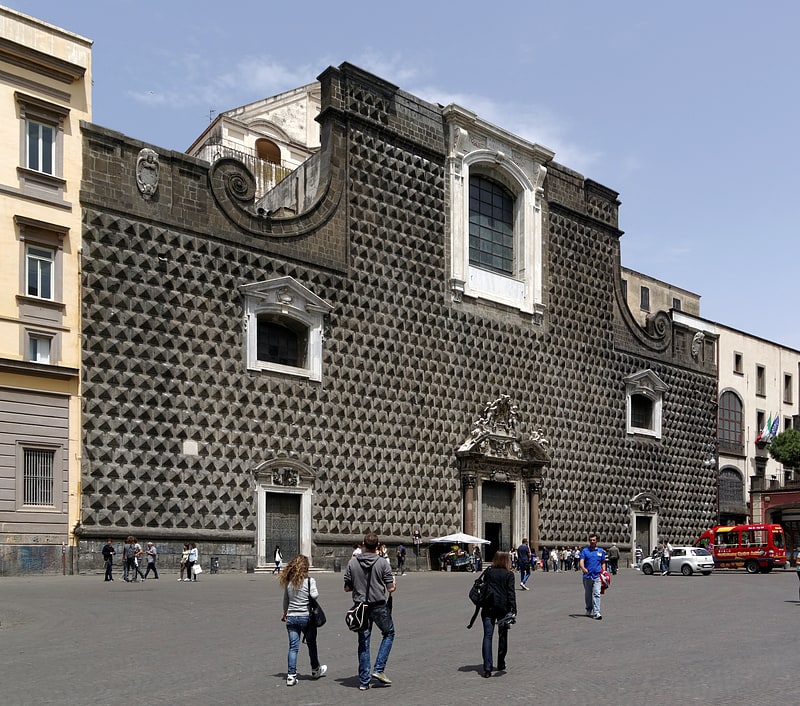
Lavish church with striking stone facade. Gesù Nuovo is the name of a church and a square in Naples, Italy. They are located just outside the western boundary of the historic center of the city. To the southeast of the spire, one can see a block away the Fountain of Monteoliveto and the piazza of the church of Sant'Anna dei Lombardi. The square is a result of the expansion of the city to the west beginning in the early 16th century under the rule of Spanish viceroy Pedro Alvarez de Toledo. The square of Gesù Nuovo contains three prominent landmarks:
- The Church of Gesù Nuovo
- The Church of Santa Chiara
- The spire or guglia of the Immaculate Virgin
Address: Piazza del Gesù Nuovo, 2, 80134 Napoli (Municipalità 2)
San Giovanni a Carbonara

Gothic church with ornate art and tombs. San Giovanni a Carbonara is a Gothic church in Naples, Southern Italy. It is located at the northern end of via Carbonara, just outside what used to be the eastern wall of the old city. The name carbonara was given to this site allocated for the collection and burning of refuse outside the city walls in the Middle Ages.[28]
Address: Via Carbonara, 4, 80139 Napoli (Municipalità 4)
Zoo di Napoli

Zoo in Naples, Italy. The Zoo di Napoli is a zoo in Naples, Campania, southern Italy, created by Franco Cuneo and Angelo Lombardi in 1940 over an area of 100,000 square metres.[29]
Naples Cathedral
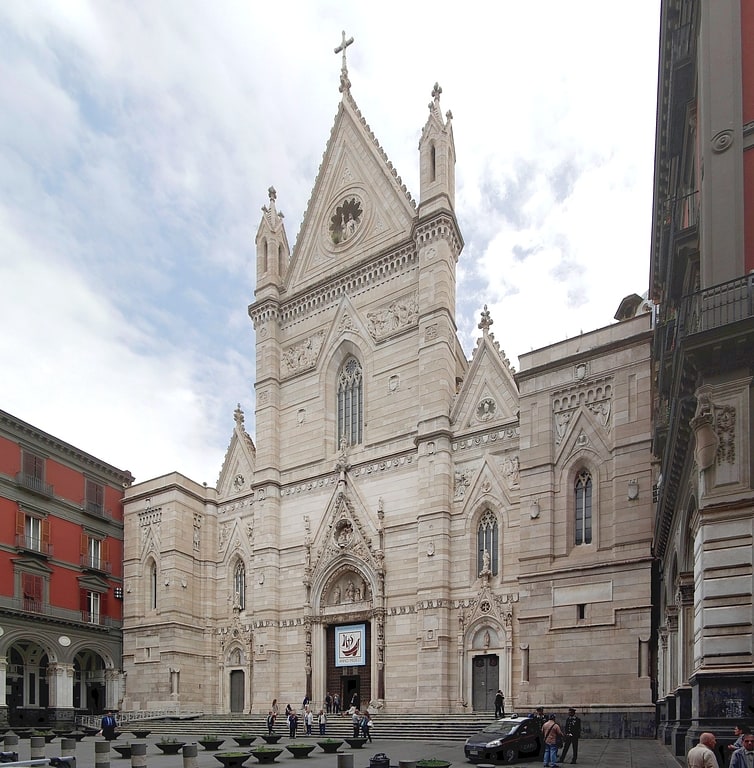
Also known as: Duomo di Napoli
Cathedral. The Naples Cathedral, or Cathedral of the Assumption of Mary, is a Roman Catholic cathedral, the main church of Naples, southern Italy, and the seat of the Archbishop of Naples. It is widely known as the Cattedrale di San Gennaro, in honour of the city's patron saint.[30]
Address: Via Duomo, 147, 80138 Napoli (Municipalità 2)
Palazzo della Prefettura
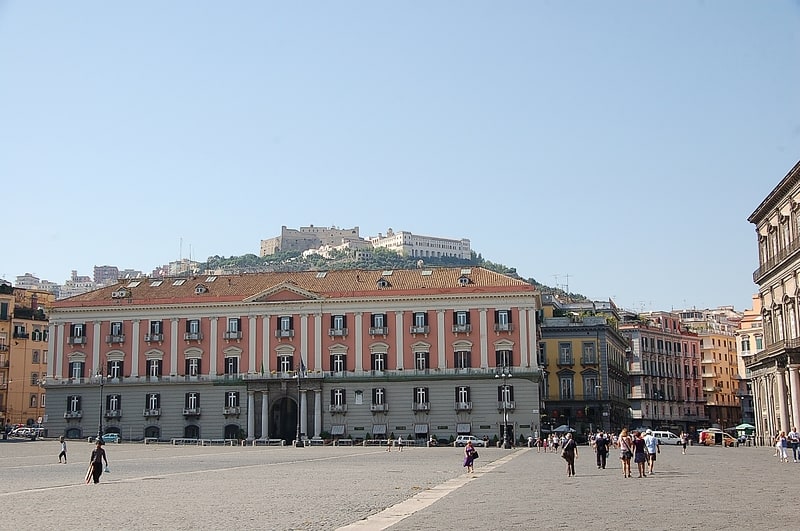
The Palazzo della Prefettura or Palace of the Prefecture is a monumental palace located in the central Piazza del Plebiscito in Naples, Italy. It stands in front and to the north of the Royal palace.[31]
Fountain of the Esedra

Landmark in Naples, Italy. The fountain of the Esedra is the largest fountain in Naples, Italy, in the vast architectural complex of the Mostra d'Oltremare.[32]
Chiesa di Santa Maria del Parto a Mergellina

Building in Naples, Italy. Santa Maria del Parto a Mergellina is a church located in the quartiere of Chiaia in Naples, Italy. The church is peculiarly perched on top of a private building, and accessed by a stairway, placed behind a restaurant located in piazza Mergellina.[33]
Address: Via Mergellina, 80122 Napoli (Municipalità 1)
Sant'Angelo a Nilo
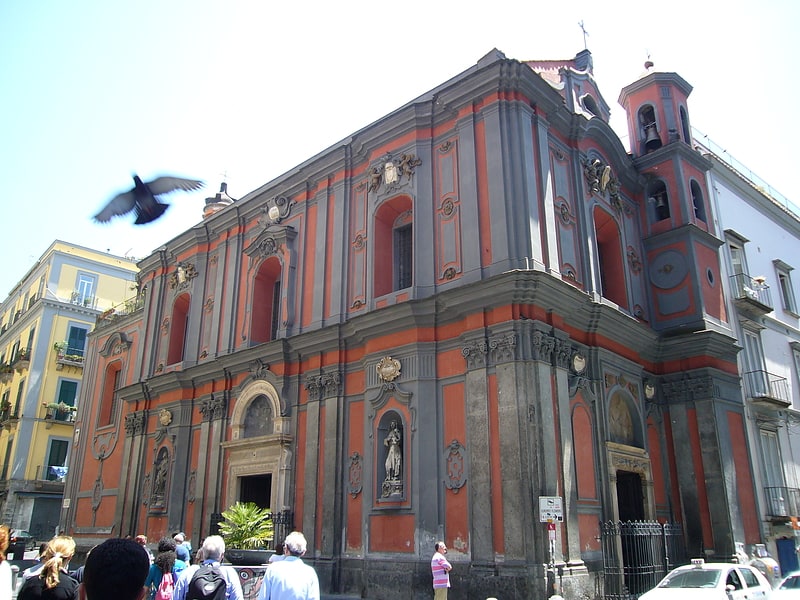
Church in Naples, Italy. Sant'Angelo a Nilo is a Roman Catholic church located on the Decumano Inferiore in Naples, Italy. It stands diagonally across from San Domenico Maggiore in Naples. It is known for containing the monumental Renaissance-style tomb of Cardinal Rainaldo Brancacci by Donatello and Michelozzo, one of the major sculptural works in the city.[34]
Address: Piazzetta Nilo, 80134 Napoli (Municipalità 2)
Palazzo di Sangro
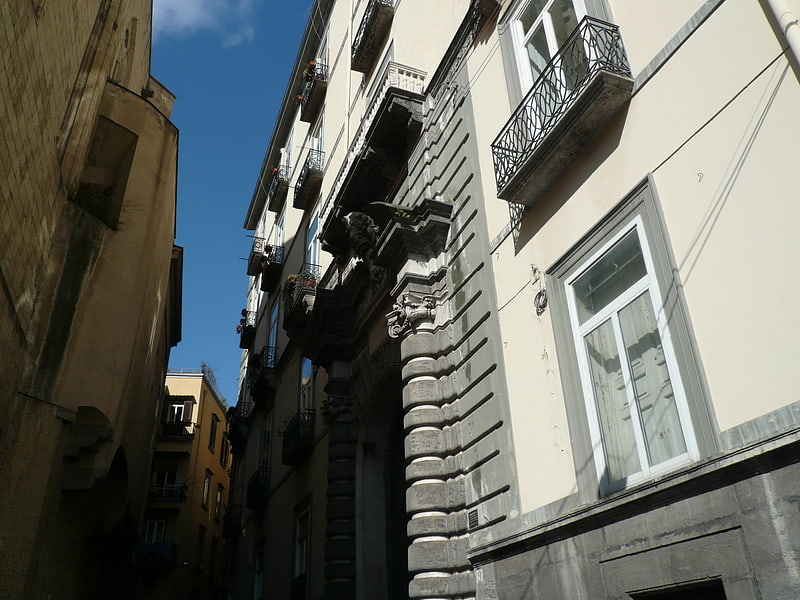
Palace in Naples, Italy. Palazzo di Sangro, also known as either Palazzo de Sangro di Sansevero or Palazzo Sansevero, is a late-Renaissance-style aristocratic palace facing the church of San Domenico Maggiore, separated by the via named after the church, in the city center of Naples, Italy. Part of the palace facade faces the piazza in front of the church, which is also bordered to the south by the Palazzo di Sangro di Casacalenda.[35]